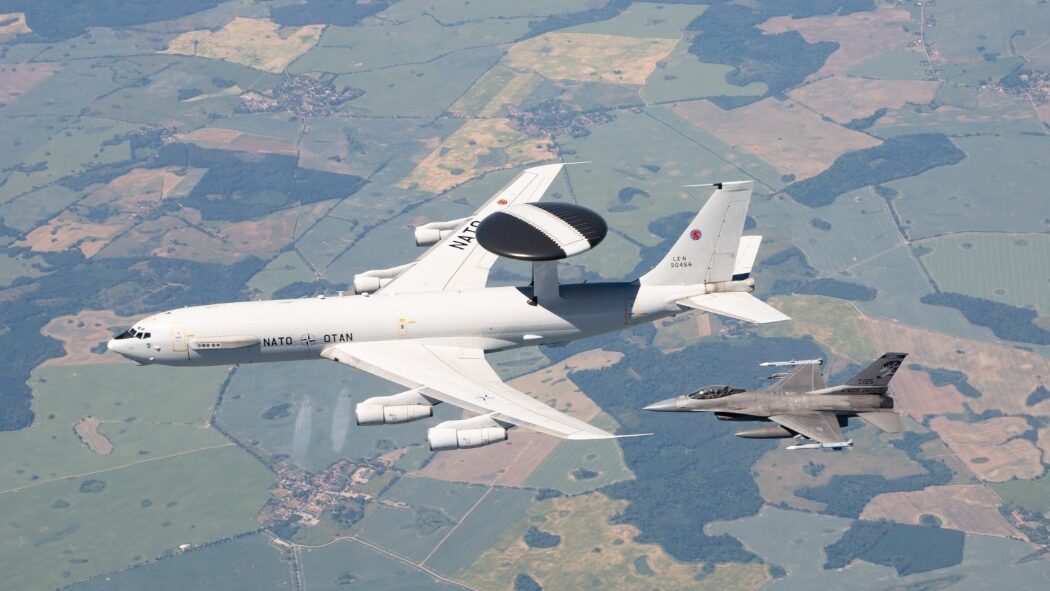
BELFAST — NATO could reduce an industry field for its Alliance Future Surveillance and Control (AFSC) program, meant to replace the aging E-3 Airborne Warning and Control System (AWACS) aircraft, in the next half year, according to an official with competitor L3Harris.
“In the next six months we believe there will be some discussions [between NATO and AFSC competitors] and downselects with a lot of pending politics behind it,” Tara Martin, senior director business development, ISR sector at L3Harris told Breaking Defense in a recent interview.
The NATO Support and Procurement Agency (NSPA) issued an AFSC capability Request for Information (RFI) in December 2022 that asked competitors to provide aircraft pricing, availability and evidence of “existing market capabilities.” NATO is currently evaluating those responses, Martin said.
A spokesperson for NATO told Breaking Defense, “Answers to the RFI released on 12 December are still being assessed and so [is] the way ahead. The deadline for this process is approaching and we will inform [press] the moment we have an update.”
In addition to Florida-based L3Harris, major US primes Boeing and Northrop Grumman are in the race, as well as Sweden’s Saab.
“Discussions with the bidders could be as soon as the third quarter of this year, but realistically they [NATO] do need to get a number of nations behind this and just discuss amongst them how they’re going to support this both from the personnel standpoint and the funding standpoint,” Martin explained.
RELATED: ‘An absolute folly’: UK lawmakers’ scathing report on E-7 Wedgetail acquisition
Long term, NATO has said AFSC will see 14 E-3A aircraft replaced with Full Operational Capability [FOC] for a new platform targeted in 2035. The first aircraft delivery is planned for 2031.
The E-3 has been in service with the alliance since the 1980’s and continues to be deployed regularly for eastern flank operations in response to Russia’s war in Ukraine.
For the replacement effort, L3Harris has proposed a Bombardier Global 6500 business jet integrated or “cross decked” with a Conformal Airborne Early Warning (CAEW) mission system fitted on Gulfstream G550 platforms, although the latter aircraft is no longer in production.
“NATO are looking for a mature solution [for AFSC] so we have partnered with the ELTA division of IAI [Israel Aerospace Industries] who have previously delivered the CAEW aircraft to Italy,” said Martin. IAI’s ELTA division specializes in mission systems, radars, electronic warfare (EW) and communication systems.
The US State Department originally approved the sale of two G550 CAEW platforms to Italy in December 2020 at a cost of $500 million.
As a result of the G550 not in production, L3Harris decided to opt for the Global 6500 for AFSC as it has a “long production lifetime ahead of it” and use company experience of cross decking mission systems from one business jet to another.

“We are moving most of our ISR capabilities going forward from the Gulfstream G550 to the Bombardier 6500 so it was a natural transition,” added Martin.
L3Harris has also previously developed the US Army Airborne Reconnaissance and Electronic Warfare System (ARES) technology demonstrator based on the Global 6000/6500 series, completing a first flight in 2021.
Deliveries For Sky Wardens For USSOCOM Expected This Fall
Back in the US, L3Harris is currently under contract to produce 15 Air Tractor AT-802U Sky Warden multi-mission aircraft, according to Martin, as part of USSOCOM’s Armed Overwatch program. The effort is expected to see delivery of 75 platforms overall.
A first delivery is planned in October, said Martin. In terms of aircraft design, USSOCOM has decided to “go mostly unchanged” from plans agreed when a contract award was first announced in August 2022, but a few “critical things” have been requested since, she noted. Those changes cover the swapping out of an onboard radio, “training scope” additions and “some safety features.”
Elsewhere, L3Harris took part in a land based Command and Control (C2) network demonstration, dubbed Everest, held at the UK Ministry of Defence’s Battlelab facility in Dorset, England last month.
The project saw successful operation of a jam-resistant C2 network that also involved integration of counter-UAS algorithms, and offensive and defensive electronic warfare applications, according to Graeme Mackay, vice president for L3Harris in the UK.
“This [demo] was really trying to look at how do they [British Army] see themselves fighting in 2026,” said Mackay.
The event could influence requirements associated with Project Morpheus, introduced to replace the British Army’s Bowman tactical communications system and the Land Cyber Electro Magnetic Activities group, according to a Janes report.
“We’ve had pretty extensive discussions post-Everest with the customer, and certainly I can see where it will replicate into other domains,” said Mackay.

